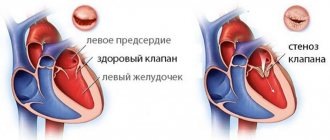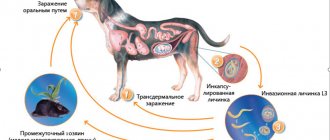Owners of female dogs carefully monitor their health, especially related to reproductive activity. Reproductive health is of great importance for animal breeders, because the good quality of the offspring and their health in the future depends on it.
The “loop” is the name given to the external genitalia of a female dog. Any discharge from the reproductive organ, if not during estrus, causes concern for owners.
Which secretions are normal, and which serve as a signal of disturbances in the body, we will consider further.
Physiological discharge from the loop
Estrus, or estrus, is an indicator of a dog's sexual maturity. According to duration, it is divided into four stages: pre-estrus, ovulation, termination and sexual rest.
Each period is accompanied by characteristic discharge from the loop.
Precursor or proestrus is a swelling of the loop and brown, bloody discharge for a week. These days you can use special panties for estrus.
Estrus (heat) is the culminating moment when ovulation occurs and the dog is allowed to mate. The secretion at this stage may be absent or light pink in color. Veterinary clinics can determine a bitch’s readiness for mating using a smear test.
Metaestrus (end of estrus) - discharge stops, the loop decreases in size.
Anestrus (sexual rest) is a period of absence of estrus, which lasts on average 100-150 days.
As a rule, the estrus cycle occurs twice a year for 10-20 days, depending on the breed of the dog.
The same natural discharge in an animal appears in the period before childbirth and in the postpartum period.
During the period associated with labor, the secreted secretion must satisfy the following characteristics:
- a maximum of two days before giving birth, the bitch notices thick discharge;
- the color of the secretion is whitish or grayish.
The listed requirements for discharge indicate the beginning of the birth process.
In the postpartum period, for two weeks (until the uterus returns to its prenatal state), brownish discharge (with a permissible blood content) may be observed for three to five days and, every day, acquiring a lighter color, until it stops completely.
Natural secretions should be transparent mucous with an acceptable content of blood impurities and not contain foreign odors or signs of inflammation.
What is the reason for discharge from the snare of a sterilized dog?
This happens extremely rarely, but there are still several possible reasons:
- during sterilization, part of the ovary remains, and the animal continues to go into estrus, and, accordingly, periodic discharge;
- cultitis - inflammation of the stump of the remaining uterus after its removal;
- vaginitis - inflammation of the vaginal walls; during sterilization, the ovaries, body and horns of the uterus are removed, the vagina is preserved, and accordingly, inflammation may occur;
- neoplasms in the vagina.
The exact cause can be determined by visiting a specialist who will prescribe specific therapy or conduct additional necessary research.
As a rule, no complications occur after sterilization, and most veterinarians recommend performing planned ones - these operations prolong the life of your pets and allow you to avoid a huge number of diseases associated with the reproductive system.
We all know that it is better to prevent any disease in time than to treat it. If any of these symptoms occur, we recommend contacting your veterinarian immediately.
Discharge from the loop related to pathologies
If the functioning of any organ in a dog’s body is disrupted, then discharge from its loop can serve as a signal of a pathological process.
Pathological discharges that you need to pay attention to and immediately visit a veterinary clinic include:
- any departments during pregnancy;
- secretion secreted before childbirth is dark in color (green, yellow, brown) with a strong putrefactive odor;
- postpartum prolonged (more than a month) sticky discharge mixed with blood;
- purulent (opaque) discharge of white color, as well as a darkish shade of yellow, green, brown or red;
- the secreted secretion has a sharp, unpleasant odor;
- the appearance of drops of blood from the external genitalia.
All these discharges indicate the development of a disease, a tumor or malignant neoplasm in the genital tract or organs of the dog.
Diagnosis by color of discharge
The type of disease can be determined by consistency and color, but these indicators are not obvious. Therefore, they still consult a doctor who prescribes effective treatment.
Whitish discharge
They indicate vaginitis - inflammation of the vaginal mucosa. The owners do not notice them or confuse them with the onset of estrus, because the female licks them. It happens in mature dogs, but juvenile (puppy) vaginitis also happens. Treatment is antibacterial therapy.
Bloody discharge in a dog
If drops of blood are released from the female's loop, this may indicate venereal sarcoma. The tumor is transmitted during mating. It affects the mucous membranes not only of the genital organs, but is more often localized there. You need to do research and choose treatment methods together with your doctor.
If your dog has purulent discharge from the loop
Abundant with a foul odor is attributed to pyometra. It occurs in two forms: when pus comes out and when it accumulates. Deadly inflammation that requires immediate treatment.
Diseases of the reproductive organs in bitches
Pathological secretions are a signal of the presence of a disease in the animal’s body that poses a danger to its health.
Diseases can be divided into the following main groups:
- inflammatory processes in the vagina (for example, vaginitis);
- inflammatory processes in the uterus (endometritis, pyometra);
- malignant neoplasms and tumors of the genital organs.
Let's look at common types of diseases:
Vaginitis occurs in the vagina and causes inflammation of its mucous membrane. The danger of the initial disease is that the owner may mistake scanty discharge for estrus and not rush to visit the clinic. The lack of timely medical care leads to the spread of infection and deterioration of the animal’s condition with aggravating diagnoses - cystitis, endometritis, pyometra.
Endometritis develops as inflammation of the endometrium or lining of the uterus. The disease can occur in acute and chronic form.
In the acute form, the animal experiences rapid development of the disease, accompanied by elevated temperature, purulent discharge from the reproductive organ, lethargy, and loss of appetite. In the absence of timely assistance from a specialist, the animal may die.
The chronic form is dangerous due to its asymptomatic nature and is manifested by the absence of pregnancy: the bitch cannot bear offspring or bears weakened ones, incapable of life; it is also possible that the duration of estrus is impaired, and a decrease in body weight is possible.
Pyometra is a dangerous inflammatory process in the uterus. This inflammation is accompanied by the accumulation of pus in the uterine cavity. If in the open form of inflammation pus is released through the cervix, then in the closed form the pus accumulates in its cavity, leading to intoxication of the body. With a closed form, there is a threat of uterine rupture, peritonitis and death of the animal.
Neoplasms in the genital organs are ovarian tumors and transmissible sarcoma (or venereal).
A pet can become infected with sarcoma during mating. A dangerous disease affects the mucous membrane of the genital organs.
Symptoms of various inflammatory processes
Despite the various foci of damage to the reproductive organs, inflammatory processes have common symptoms of the disease.
Characteristic symptoms of inflammatory processes in the genital organs, in addition to existing discharge, include:
- excessive attention of the animal to the genitals: the pet licks the loop more often than usual due to itching from the secretion;
- lethargy is noted in behavior;
- temperature increase;
- increase in abdominal volume;
- thirst - the animal consumes a lot of water, vomiting is possible;
- depressed state;
- hard breath;
- weakness;
- refusal to go for a walk;
- Frequent urination, including at home.
If the symptoms described above appear, you should not self-medicate. It is important to understand that the disease in its advanced form is much more difficult to cure, and if assistance is delayed, the result may be the death of the pet.
Causes of diseases
Diseases of the reproductive system, accompanied by discharge from the genitals, cause physical inconvenience and suffering to pets in the absence of proper medical care.
The causes of diseases are:
- Hormonal disbalance. During puberty or during estrus, the body's defenses weaken and cannot resist the attacks of infection.
- Uncontrolled matings.
- Missing matings.
- Traumatic injuries to the external genitalia.
- Unsanitary conditions, failure to comply with hygiene rules, especially during childbirth.
- Damage to the internal reproductive organs (uterus) during the birth of large puppies.
- Infection of a bitch with a sexually transmitted infection during mating.
- Poorly selected medications or hormonal drugs that have dangerous side effects.
Diagnosis of diseases in dogs
If your pet has purulent discharge from the urethra, you should contact your veterinarian. The doctor will examine the animal and assess the condition of the urinary organs. Pay attention to symptoms such as swelling, inflammation, spots or wounds in the genital area.
The doctor will also measure the pet’s temperature and assess the dog’s general condition. The owner should inform the veterinarian about symptoms such as refusal to eat, lethargy, excessive licking of the animal's genitals, strong odor, frequent or difficult urination, etc.
After a general examination, the doctor prescribes tests and diagnostic procedures:
- urine and blood tests (biochemistry, general tests);
- culture of urethral discharge to determine the presence of bacteria;
- X-ray of the abdominal cavity to assess the condition of the prostate and urinary tract in males; in females, this procedure allows to evaluate the reproductive organs (uterus);
- Ultrasound of the abdominal cavity to study internal organs (prostate, bladder, uterus, ovaries, etc.);
- a biopsy of abnormal tissue found in the vagina or urethra.
A deadly disease, which in some cases is accompanied by purulent vaginal discharge, is pyometra.
With this disease, pus accumulates in the uterus. The animal's stomach swells, the dog becomes lethargic, and its temperature rises. Without timely assistance, the pet dies a few days later from uterine rupture.
To accurately detect the cause of purulent discharge, you need to consult a veterinarian
Diagnostics in a veterinary clinic
If you notice any abnormalities in your pet's well-being: mucus discharge from the external genitalia, excessive licking, you should not miss the moment and promptly contact a veterinary clinic. This will allow you to diagnose your pet and prescribe a course of treatment, preventing the development of the disease and possible complications.
When examining an animal, the veterinarian should obtain information about the nature and duration of discharge, periods of estrus and the number of pregnancies and births.
During the examination, the pet’s body temperature is measured, the abdominal cavity is palpated, and the condition of the mucous membranes and vagina is examined.
Next, an ultrasound examination is prescribed, which allows you to check the condition of the uterus and its walls, and identify neoplasms: cysts or tumors.
Blood and urine tests are required. These tests will clarify the general condition of the animal, help identify the inflammatory process and evaluate the functioning of the urinary system. According to the doctor’s decision and for laboratory testing, a vaginal smear is analyzed.
If a pet has heart rhythm disturbances, the doctor will refer the patient for an ECG; if necessary, an ultrasound and chest x-ray may be prescribed.
Based on the examination, the doctor makes a diagnosis and develops a treatment plan for the animal.
As a rule, along with antibacterial, antipyretic drugs and antibiotics, the doctor prescribes solutions to maintain water-salt balance and immunomodulating drugs. To speed up the regeneration of the mucous membrane and depending on the condition of the pet, the doctor recommends vitamin complexes.
In some cases, due to the lack of effect of the prescribed treatment, the need for bacteriological culture arises. This analysis will allow you to select a drug with a targeted spectrum of action, depending on the characteristics of the animal’s microflora.
If neoplasms are detected in the pelvic organs, the doctor will discuss surgical intervention and its possible consequences with the owner.











